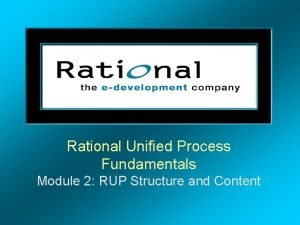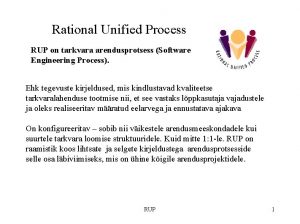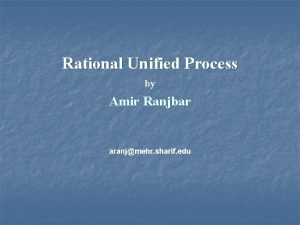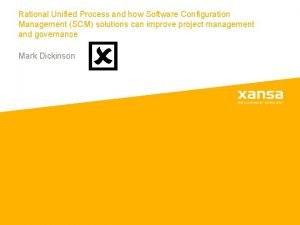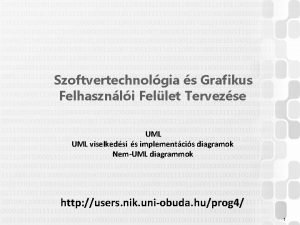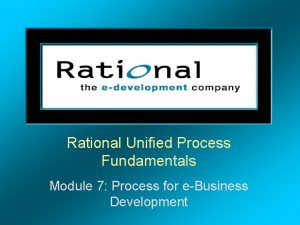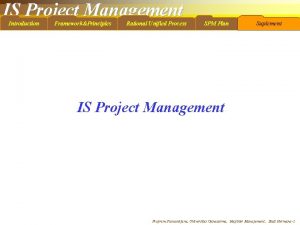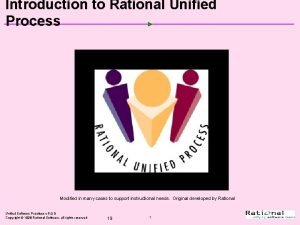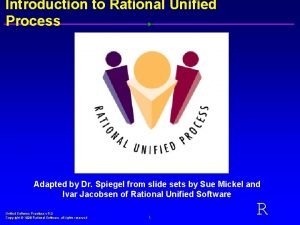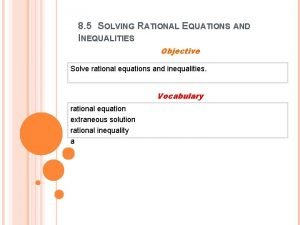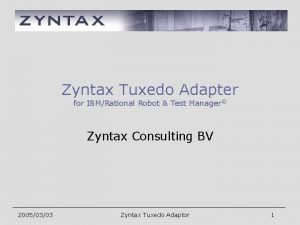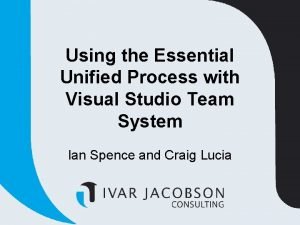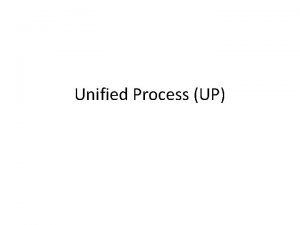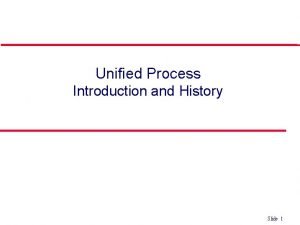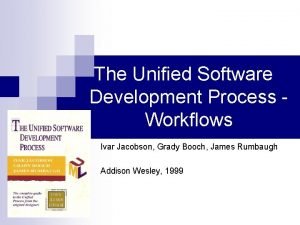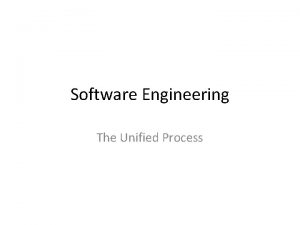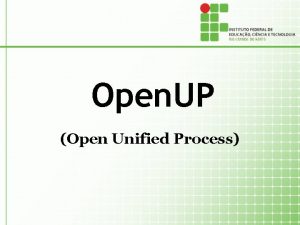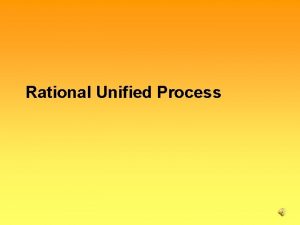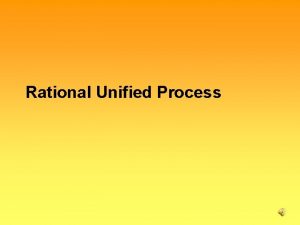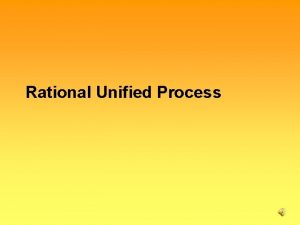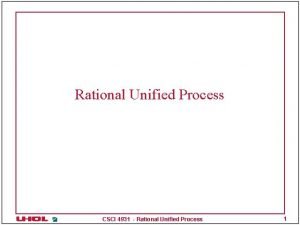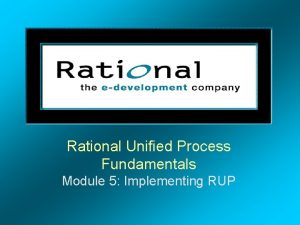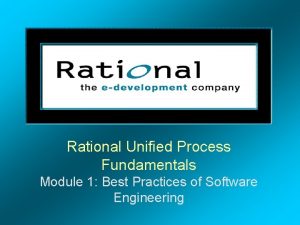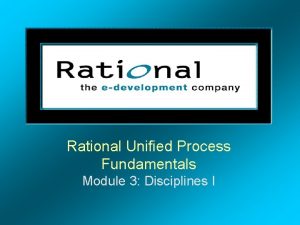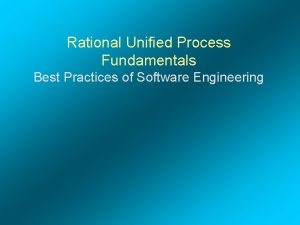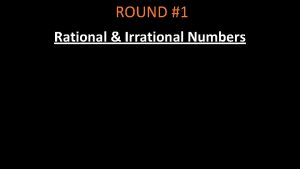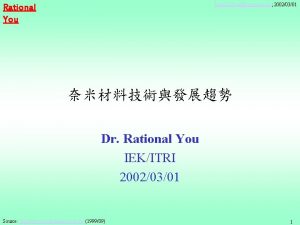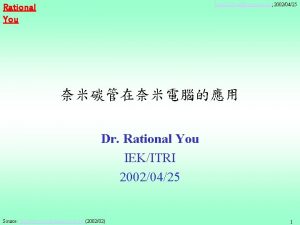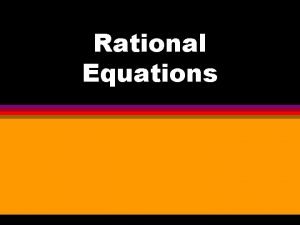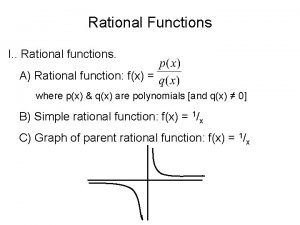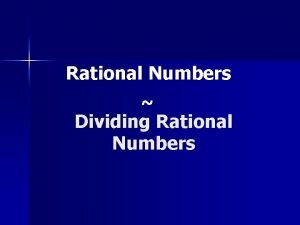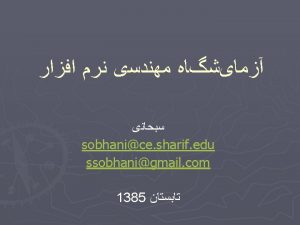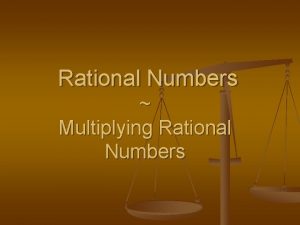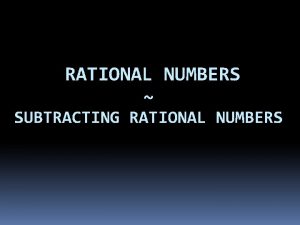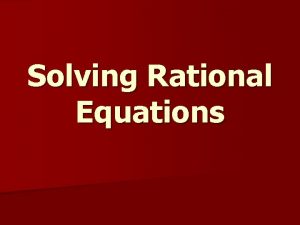Rational Unified Process Fundamentals Module 7 Process for



































- Slides: 35

Rational Unified Process Fundamentals Module 7: Process for e-Business Development

Objectives: Process for e-Business Development w Understand the use of e-Business applications to implement business processes w Understand concepts and technologies for e -Business solutions w Examine process customization for e. Business development Rational Unified Process Fundamentals, v. 2000. 02. 10 Copyright © 2000 Rational Software, all rights reserved 2

Definition: e-Business Building systems (business tools) that automate business processes Rational Unified Process Fundamentals, v. 2000. 02. 10 Copyright © 2000 Rational Software, all rights reserved 3

Generations of e-Business systems • Use the web to publish information Rational Unified Process Fundamentals, v. 2000. 02. 10 Copyright © 2000 Rational Software, all rights reserved • Implement e -commerce and simple transactional models 4 • Reengineer a process to provide highly personalized, adaptive solutions. • Automate the complete business process, often integrating with legacy systems and internet devices.

Categories of e-Business Development w Customer to business (C 2 B) w Business to business (B 2 B) w Business to customer (B 2 C) w Customer to customer (C 2 C) Rational Unified Process Fundamentals, v. 2000. 02. 10 Copyright © 2000 Rational Software, all rights reserved 5

Characteristics of e-Business Development w Externally imposed rules and regulations, often of high complexity (business rules) w Interface with legacy data structures w Customer focus w Compressed time schedules w Concern for performance and reliability of the final system Rational Unified Process Fundamentals, v. 2000. 02. 10 Copyright © 2000 Rational Software, all rights reserved 6

Contrast with Traditional Development w More emphasis on business modeling w More emphasis on user-interface § graphic design § anonymous users w Use of e-Business enabling technologies to define the architecture § inherently distributed architecture w Greater focus on performance testing § unpredictable loads Rational Unified Process Fundamentals, v. 2000. 02. 10 Copyright © 2000 Rational Software, all rights reserved 7

The Role of Enabling Technologies in e-Business Changed Business Practices Technological Advances Rational Unified Process Fundamentals, v. 2000. 02. 10 Copyright © 2000 Rational Software, all rights reserved New Business Opportunities 8

RUP Content for e-Business Development w Roadmap: Developing e-Business Solutions § Extends the process based on technology issues § Emphasizes related parts of workflow § Provides more specific information for activities § Suggests appropriate artifacts § Introduces related concepts Rational Unified Process Fundamentals, v. 2000. 02. 10 Copyright © 2000 Rational Software, all rights reserved 9

Process Variation Based on Phases Roadmap: Developing e-Business Solutions Rational Unified Process Fundamentals, v. 2000. 02. 10 Copyright © 2000 Rational Software, all rights reserved 10

E-business Process Variation: Phases èBusiness Modeling w Requirements w Analysis & Design w Implementation w Test w Environment Rational Unified Process Fundamentals, v. 2000. 02. 10 Copyright © 2000 Rational Software, all rights reserved 11

Process Variation in Business Modeling w Compared to system modeling. . . § Increased prominence of business modeling § Greater variety of stakeholders w For e-Business modeling. . . § Limit scope to area of influence § Identify automated and non-automated parts of the business § Consider role of legacy systems Rational Unified Process Fundamentals, v. 2000. 02. 10 Copyright © 2000 Rational Software, all rights reserved 12

Six Scenarios for Business Modeling (review) w Organization chart w Domain modeling w One business, many systems w Generic business model w New business w Revamp Rational Unified Process Fundamentals, v. 2000. 02. 10 Copyright © 2000 Rational Software, all rights reserved 13

Business Processes? Branch office Credit department Loan committee New loan: from Loan application to Loan disbursement Business Process w. A set of internal activities performed to serve a customer w. The purpose is to offer each customer the right product or service w. Cuts right through functional organization structures; requires changes in organizational structures Rational Unified Process Fundamentals, v. 2000. 02. 10 Copyright © 2000 Rational Software, all rights reserved 14

The Fundamental Business Goal? Perceived Value The Company Business process A Business process B Business process C A Customer is a “User of the Company” Rational Unified Process Fundamentals, v. 2000. 02. 10 Copyright © 2000 Rational Software, all rights reserved 15

Example Business Use-Case Model Business actor represents a role played in relation to the business by someone or something. Business use case - a sequence of actions performed in a business that produces a result of observable value to an individual actor of the business. Core business processes for a generic software solution vendor Rational Unified Process Fundamentals, v. 2000. 02. 10 Copyright © 2000 Rational Software, all rights reserved 16

E-business Process Variation: Phases w Business Modeling èRequirements w Analysis & Design w Implementation w Test w Environment Rational Unified Process Fundamentals, v. 2000. 02. 10 Copyright © 2000 Rational Software, all rights reserved 17

Process Variation in Requirements w Rely on the business assessment and organization description from Business Modeling. w Rely on stakeholder input obtained during Business Modeling. w Let the system boundaries reflect the business boundaries (the system is the business). Rational Unified Process Fundamentals, v. 2000. 02. 10 Copyright © 2000 Rational Software, all rights reserved 18

Business Model Input to Requirements Rational Unified Process Fundamentals, v. 2000. 02. 10 Copyright © 2000 Rational Software, all rights reserved 19

User-Centered Design w Business success depends on accommodating users § Varying legislation around the globe § Standards organizations § Involve and observe users § Integrate interface development with design § Iterative design Rational Unified Process Fundamentals, v. 2000. 02. 10 Copyright © 2000 Rational Software, all rights reserved 20

Model the User Interface w Focus on user interface usability w Create a storyboard w Find boundary classes as preparation for an object-oriented interface w Prepare userinterface prototype Rational Unified Process Fundamentals, v. 2000. 02. 10 Copyright © 2000 Rational Software, all rights reserved 21

Multiple Dimensions to User-Centered Design Rational Unified Process Fundamentals, v. 2000. 02. 10 Copyright © 2000 Rational Software, all rights reserved 22

Concept Overlap for Functional Requirements Rational Unified Process Fundamentals, v. 2000. 02. 10 Copyright © 2000 Rational Software, all rights reserved 23

E-business Process Variation: Phases w Business Modeling w Requirements èAnalysis & Design w Implementation w Test w Environment Rational Unified Process Fundamentals, v. 2000. 02. 10 Copyright © 2000 Rational Software, all rights reserved 24

Process Variation in Analysis & Design w Web architecture is well-defined. w Focus on GUI and business logic. w Use UML Extension for Web Applications w Map non-functional system requirements to web development framework. w Focus on web server, application server (processes and threads). w Describe distribution for scalability and fault tolerance. Rational Unified Process Fundamentals, v. 2000. 02. 10 Copyright © 2000 Rational Software, all rights reserved 25

Business Model Input to Analysis and Design Rational Unified Process Fundamentals, v. 2000. 02. 10 Copyright © 2000 Rational Software, all rights reserved 26

Using UML for Web Application Architectures w UML designed to allow formal extensions § stereotypes (icons), tagged values, constraints w Distinction between business logic and presentation logic w Allows modeling of web page behavior on client and server Rational Unified Process Fundamentals, v. 2000. 02. 10 Copyright © 2000 Rational Software, all rights reserved 27

Three Common Web Architecture Patterns w Thin web client § Minimal client configuration § Minimal computing power § Business logic on the server w Thick web client § Client-side scripting and custom objects § Some business logic w Web delivery § Web as delivery mechanism for a distributed client/server system Rational Unified Process Fundamentals, v. 2000. 02. 10 Copyright © 2000 Rational Software, all rights reserved 28

E-business Process Variation: Phases w Business Modeling w Requirements w Analysis & Design èImplementation w Test w Environment Rational Unified Process Fundamentals, v. 2000. 02. 10 Copyright © 2000 Rational Software, all rights reserved 29

Process Variation in Implementation w Architectural prototypes w Component implementation § browser environment § server-side § legacy enhancements § database enhancements w Subsystem integration w System integration Rational Unified Process Fundamentals, v. 2000. 02. 10 Copyright © 2000 Rational Software, all rights reserved 30

E-business Process Variation: Phases w Business Modeling w Requirements w Analysis & Design w Implementation èTest w Environment Rational Unified Process Fundamentals, v. 2000. 02. 10 Copyright © 2000 Rational Software, all rights reserved 31

Process Variation in Test w Test for a scalable and Reliable Architecture § Benchmark testing § Contention testing § Performance profiling § Load testing § Stress testing w Appropriateness of web site structure w Browser compatibility Rational Unified Process Fundamentals, v. 2000. 02. 10 Copyright © 2000 Rational Software, all rights reserved 32

E-business Process Variation: Phases w Business Modeling w Requirements w Analysis & Design w Implementation w Test èEnvironment Rational Unified Process Fundamentals, v. 2000. 02. 10 Copyright © 2000 Rational Software, all rights reserved 33

Process Variation in Environment w Develop user-interface guidelines § e. g. ‘Design Brief’ w Web-site consistency w Develop web UI prototype Rational Unified Process Fundamentals, v. 2000. 02. 10 Copyright © 2000 Rational Software, all rights reserved 34

Summary: Process for e-Business Development w What is an “e-Business”? w How is e-Business development different from traditional development? w What role do business models play in edevelopment? w Give examples of the process variant for e. Business development. Rational Unified Process Fundamentals, v. 2000. 02. 10 Copyright © 2000 Rational Software, all rights reserved 35
 Rup rational unified process
Rup rational unified process Rup project management
Rup project management Rational unified process
Rational unified process Rational unified process
Rational unified process Software
Software Uml activity diagram
Uml activity diagram Rational unified process diagram
Rational unified process diagram Rational unified process diagram
Rational unified process diagram Rational unified process diagram
Rational unified process diagram Language uml
Language uml Rational equation and rational inequalities
Rational equation and rational inequalities Apa itu tuxedo
Apa itu tuxedo C device module module 1
C device module module 1 Essential unified process
Essential unified process Unified process (up)
Unified process (up) Unified process in ooad
Unified process in ooad Software process workflows
Software process workflows Unified engineering software
Unified engineering software Open unified process (openup)
Open unified process (openup) Iso 22301 utbildning
Iso 22301 utbildning Typiska novell drag
Typiska novell drag Nationell inriktning för artificiell intelligens
Nationell inriktning för artificiell intelligens Vad står k.r.å.k.a.n för
Vad står k.r.å.k.a.n för Varför kallas perioden 1918-1939 för mellankrigstiden?
Varför kallas perioden 1918-1939 för mellankrigstiden? En lathund för arbete med kontinuitetshantering
En lathund för arbete med kontinuitetshantering Kassaregister ideell förening
Kassaregister ideell förening Personlig tidbok för yrkesförare
Personlig tidbok för yrkesförare Sura för anatom
Sura för anatom Densitet vatten
Densitet vatten Datorkunskap för nybörjare
Datorkunskap för nybörjare Stig kerman
Stig kerman Debatt mall
Debatt mall Magnetsjukhus
Magnetsjukhus Nyckelkompetenser för livslångt lärande
Nyckelkompetenser för livslångt lärande Påbyggnader för flakfordon
Påbyggnader för flakfordon Tryck formel
Tryck formel

